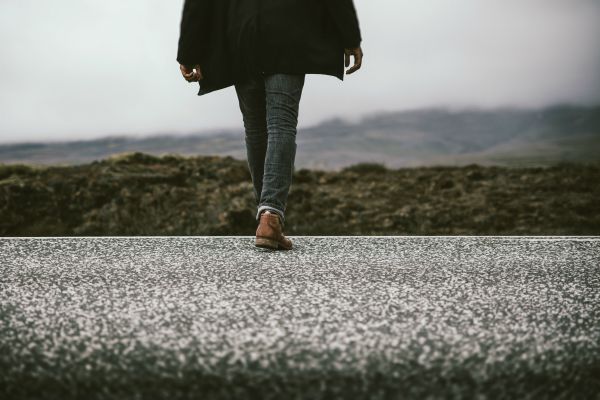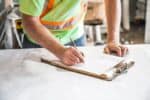Plantar fasciitis is more common than you think. If you think that only nerve damage or musculoskeletal issues cause Plantar fasciitis, then you’re wrong. Walking on concrete floors without wearing protective and comfortable shoes and socks is responsible too.
Although concrete floors have many advantages in general, they’re also responsible for causing Plantar fasciitis. Since most of the flooring at home as well as the workplace (even roads) is made of concrete, Plantar fasciitis has become a major issue.
Yes, there are medicines and treatments for the same, but, at times, they’re not even needed if you wear the right pair of socks and shoes.

In this guide, we will take you through the many ways in which you can reduce the swelling and inflammation caused by Plantar fasciitis, the best shoes and socks that can help reduce discomfort, and some additional tips that will help you get rid of excessive pain that occurs while walking on concrete floors.
Reducing Inflammation Caused by Plantar Fasciitis – Can Walking on Concrete Floors Cause Plantar Fasciitis?
To come out straight and clear the air once and for all, the answer is yes! Yes, walking on concrete floors causes Plantar fasciitis. In fact, it’s one of the leading reasons behind pain and inflammation due to this condition.
As true as this is, another fact is that you can’t stop walking on concrete floors, isn’t it? 80% of infrastructure in offices, construction sites, homes, driveways, and walkways is concrete. Naturally, walking on concrete is, thus, inevitable
You can change the flooring in your house, but most of the walking happens at workplaces. Needless to say, a sedentary lifestyle isn’t the solution (it will only bring more troubles).
The solution is wearing the right shoes and socks to reduce pain and swelling caused by Plantar fasciitis and offer relief in the long run.
Now that you know the solution, you might want to know how shoes and socks can reduce something as painful as Plantar fasciitis! If yes, then, Sirs and Madams, we have the answers and we have listed them in the coming sections.
How Do Shoes and Socks Reduce Pain Caused by Plantar Fasciitis?
Plantar fasciitis is acute heel pain that happens if there’s excessive pressure on the heels of the feet.
Whether it’s being overweight that’s been exerting that additional pressure or long-standing and walking hours you spend at work, the right pair of shoes and socks can reverse the pain and swell in the following ways.
1.) The right pair of shoes have a shank. The shank balances the feet at the widest part so that all the weight is evenly distributed. Naturally, it ensures that the heels aren’t over-exerted. In the longer run, it can help you get rid of the pain caused by plantar fasciitis completely.
2.) Padded, cushioned, or compression socks offer support and comfort. They protect the feet from getting in touch with the hardest parts of the shoes you’re wearing. As a result, the pain reduces significantly.
3.) The width at the front of the shoes allows you to stretch your feet. When the feet aren’t trapped inside excessively tight (or wobbly inside very loose) shoes, the heels stay put where they’re supposed to be.
As long as you can stretch your feet and wiggle your toes, the ligaments that join the heel and the front of the toes will get a lot of relief. Hence, picking the right shoes and socks is very important when you walk on concrete floors.
How to Pick the Right Shoes and Socks to Get Rid of Pain that Plantar fasciitis Causes?
There are certain elements that shouldn’t be ignored when buying shoes and socks to get relief from plantar fasciitis. Have a look!
Picking the Right Shoes for plantar fasciitis:
1.) The shoes should offer support to the calf muscles too. Since the pressure on the calf muscle triggers swelling and inflammation caused due to plantar fasciitis, wearing something that can support those muscles is essential.
2.) The shoes should have a thick cushioning at the base of the heels. The insole, midsole, and outsole should offer shock absorption. (Are Vibram Soles Good on Concrete?)
3.) The shoes shouldn’t be too hard or rigid. They should be flexible. Only when the shoes support the flex in the foot that occurs while walking that the ligaments involved in plantar fasciitis will be able to stretch. Bear in mind, motion is required to encourage the flow of blood. That’s how the feet muscles stay relaxed.
4.) Don’t buy shoes that are too tight or too loose. The best shoes are the ones that have a shank or some sort of support provided to help your feet align with the surface of the shoes.
5.) Shoes that are too narrow aren’t recommended when you’re already suffering from plantar fasciitis.
Picking the Right Socks for plantar fasciitis:
1.) The right socks should be breathable and stretchable.
2.) They should be either padded or should offer compression.
3.) Compression socks that can offer support to the calf muscles and ankles are the best examples of socks that offer relief from pain and swelling caused due to plantar fasciitis.
4.) Normal ankle socks might not be useful if you already have plantar fasciitis. Only compression ankle socks are recommended if you have plantar fasciitis. Ideally, the calf-length compression socks are very good.
Best Shoes for Plantar Fasciitis
1.) New Balance Women’s 608 Comfort Cross Trainer Shoes by V5
- PU Foam insert offers long-lasting comfort and support
- Lightweight injection-molded EVA foam midsole provides lightweight cushioning
- Phantom Liner interior has minimal seaming to help reduce irritation
- Internal midsole shank adds midfoot structure and support
- NB Soft + Supportive Comfort Insert offers all-day comfort and support
Prices pulled from the Amazon Product Advertising API on:
Product prices and availability are accurate as of the date/time indicated and are subject to change. Any price and availability information displayed on [relevant Amazon Site(s), as applicable] at the time of purchase will apply to the purchase of this product.
These extremely comfortable cross-trainer shoes have a shank. They’re ideal for women who have plantar fasciitis.
1.) They offer support to the arch of the feet so that no extra pressure is created on the heels while walking on concrete floors.
2.) The midsole is cushioned and the shoes aren’t bulky. All this reduces a lot of stress and tension from the areas around the heel of the feet.
3.) They feature an insert that’s made of polyurethane. It adds more comfort while walking. Besides, the insert offers shock absorption too.
The downside that users report is the price of these shoes. However, they’re absolutely worth the price since they offer wonderful support to the heels whether you stand, walk, or run on concrete floors.
2.) The Max-54601 Skechers Men’s Performance Sneaker Shoes
- Get the maximum comfort and cushioning for athletic walking with the Skechers GOwalk Max. Mesh fabric upper with cushioned, supportive sole design.
- UPPER: Super lightweight mesh fabric upper for ideal fit. Solid weave mesh fabric toe and heel panels for stability.
- MIDSOLE/CUSHION: 5GEN sole - proprietary lightweight injection-molded compound with memory retention helps absorb impact.
- INSOLE: Goga Max technology insole for maximum support and cushioning.
Prices pulled from the Amazon Product Advertising API on:
Product prices and availability are accurate as of the date/time indicated and are subject to change. Any price and availability information displayed on [relevant Amazon Site(s), as applicable] at the time of purchase will apply to the purchase of this product.
The shaft of these shoes steals the cake since it offers extra support. It keeps the feet properly aligned with the shoes. When walking on concrete floors, the extra padding at the heel helps further.
1.) The padded collar alongside the lace-up design supports the feet like nothing else. It offers a lot of shock absorption that comes with walking on concrete floors.
2.) The shoes are incorporated with toe and heel panels that distribute the pressure evenly.
3.) Designed using the Goga Max Technology, the insoles of these shoes offer rebound cushioning.
There’s nothing other than the price that we, and most users, can think of when discussing the cons of these shoes.
3.) Women’s Devotion Plus 2 Walking Shoe by Ryka
- Weighs 8.3 oz
- Breathable mesh upper with supportive synthetic overlays
- Anatomical precise-return footbed
- Lightweight molded eva outsole features a full length rezorb platform; external pod network between midsole and outsole, and full length internal insert
Prices pulled from the Amazon Product Advertising API on:
Product prices and availability are accurate as of the date/time indicated and are subject to change. Any price and availability information displayed on [relevant Amazon Site(s), as applicable] at the time of purchase will apply to the purchase of this product.
These walking shoes for plantar fasciitis are perfect for walking on concrete floors as well as other surfaces such as tiles. In fact, you can also wear them while running on a treadmill. They’re almost as good as any high-end recovery shoes that athletes suffering from plantar fasciitis wear.
1.) They feature a comfort collar that offers extra support.
2.) Cushioned insoles are a bonus for ease of movement.
3.) The midsole and insole offer excellent arch support to mitigate pressure from the heels while standing and walking.
Best Socks For Plantar Fasciitis
1.) UNISEX Compression Socks by ActinPut
- NEW DESIGNED COMPRESSION SOCKS - Feel the immediate Comfort and remarkable design of your new Low Cut Running Compression Socks.
- RELIEVE YOUR PAIN - ACTINPUT compression technology (8-15mmHg) provides the ideal compression to improve blood flow, move faster, react quicker and use less energy.
- ARCH SUPPORT - Targeted compression zones provide varying levels of support from moderate to extra firm.
- COMFORTABLE TO WEAR - Durable with a fashionable look & various colors available.
- 100% MONEY BACK GUARNTEE: Order now, with a peace of mind,RISK FREE. 30 Days Money Back Guarante
Prices pulled from the Amazon Product Advertising API on:
Product prices and availability are accurate as of the date/time indicated and are subject to change. Any price and availability information displayed on [relevant Amazon Site(s), as applicable] at the time of purchase will apply to the purchase of this product.
These are some of the very best socks for plantar fasciitis in both men and women. They are 80% nylon and 20% polyester. The many reasons why they offer quick recovery from plantar fasciitis are as follows.
1.) They create pressure at the right places only so that blood circulation is promoted, not constricted.
2.) They are very flexible but strong enough to support the feet very nicely while running, walking on concrete, and even hiking.
3.) They reduce both fatigue and cramps that come from walking on concrete floors.
Other general benefits are: they’re lightweight, breathable, durable, moisture-wicking, and easy to wash.
2.) UNISEX Plantar Fasciitis Compression Socks by SB SOX
- #1 Recommended Design – Our compression foot sleeves are recommended by doctors and preferred by trainers. The targeted ribbing arch support provides unmatched comfort and pain relief for your feet.
- Great Investment For Your Feet (Great Gift Idea Too!) – We spend so much time on our feet yet tend to neglect our feet.
- Purchase The Right Size For You - For the best fit, we recommend that our customers do the following two steps prior to purchasing the foot sleeves: (1) measure their arch circumference and (2) then select their size using the 4th image in our listi
Prices pulled from the Amazon Product Advertising API on:
Product prices and availability are accurate as of the date/time indicated and are subject to change. Any price and availability information displayed on [relevant Amazon Site(s), as applicable] at the time of purchase will apply to the purchase of this product.
The arch support that these compression socks offer is unlike any. They offer instant pain relief while walking on concrete floors. When paired with the right pair of shoes, these socks are no less than recovery socks that athletes wear during ligament tears.
1.) They offer targeted compression only. Hence, your feet won’t hurt. Instead, the hurting plantar fasciitis will get better when you wear these socks regularly.
2.) If you don’t prefer the idea of wearing socks that don’t cover the front of the feet, you can actually wear these socks as under-socks too.
Some people might not like the idea of socks open from the front. If you’re too fussy about it and unwilling to wear these compression socks as under socks, it’s better you don’t buy them.
However, most trainers, Pilate experts, and even doctors recommend wearing these socks for pain relief due to plantar fasciitis.
One issue that you might face is their price. Though, every penny spent is worthy because these socks offer almost immediate pain relief and last for a long time.
See also: Are Logger Boots Good for Standing on Concrete?
Conclusion:
It’s not always necessary to take medicines or undergo expensive therapies to treat plantar fasciitis.
Unless the ligaments are completely torn and badly damaged, wearing the right pair of shoes and compression socks can offer a lot of relief from plantar fasciitis that’s caused by walking on concrete floors. You can also wear relief insoles for added arch support if you wish.
Leaving plantar fasciitis untended can cause a lot of discomfort and the ligaments will develop injury over time.
So, switch to wearing the right shoes and socks (that are neither too tight nor too loose) to prevent plantar fasciitis in the first place and to mitigate (even reverse) the damage done if you already have plantar fasciitis.













